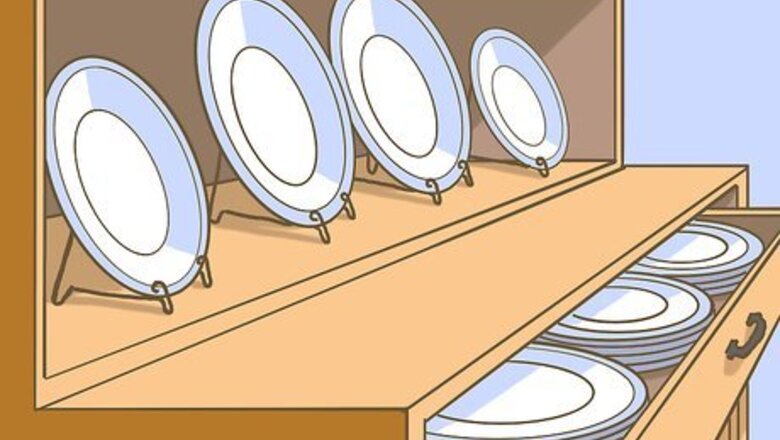
views
Displaying Plates with Individual Stands
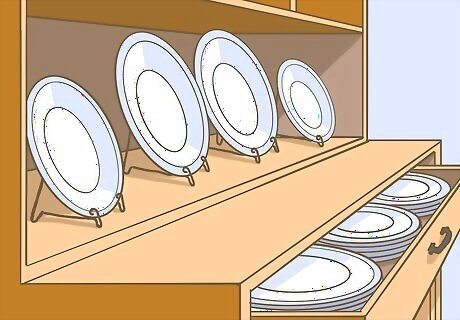
Use 1 stand for each plate that you want to display. Are you going to show off your entire collection, or are there just a few main pieces you’d like to highlight? Count how many plates you need stands for based on what you want displayed. The size of your cabinet may affect how many plates you can set up, too. If you don’t have a lot of space, pick and choose your favorite pieces, then store the rest in the drawers underneath or in another safe spot.
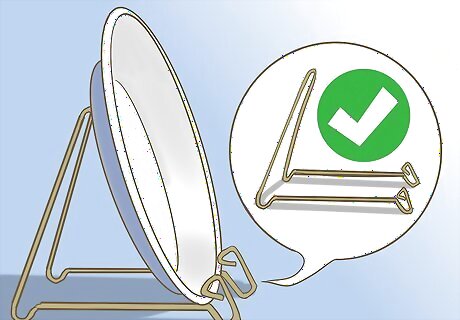
Pick stands that match your decor and are big enough for your plates. Stands come in all different materials, like acrylic, wire, or plastic. Choose whatever you like or what matches the style of your dining room. Make sure the stands you select are large enough to support your plates, too. A good rule of thumb is to use a stand that’s at least 3/4 the height of your plate. For example, if you have a plate that’s 12 inches (30 cm), you’ll want a stand that’s at least 9 inches (23 cm) tall. You can buy plate stands from a craft store or online retailer, or make the stands yourself. How to Make Your Own Plate Stand 1. Use wire cutters to cut off the bottom of a wire hanger 2. Bend the detached bottom piece in the middle, then bend the ends outwards 2 inches (5.1 cm) from the tips. 3. Bend the ends upwards 1 inch (2.5 cm) from the tips. This will form the prongs that hold the bottom of the plate.
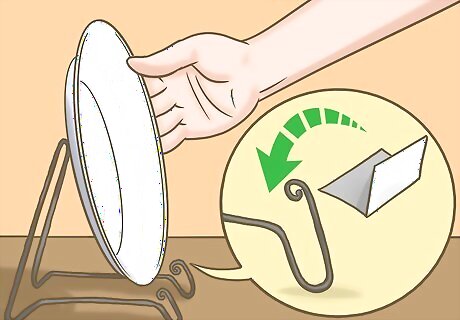
Balance your plates on the stands and set them on the shelf. The stands will generally have two prongs or a ridge along the front with a higher ridge at the back. Gently position the bottom of your plate against the front prongs or ridge of the stand, then rest the back of the plate against the taller piece. If you’re worried about your plates getting scratched by a stand, particularly if your stand is metal, place a small square of felt over the prongs or ridge before you set the plate against it.

Arrange your china so that the largest plates are in the back. This not only fills the space nicely, it also prevents smaller pieces from being hidden. Move the tallest plates to the back of the cabinet, then set the other ones in front of them in decreasing height order, so that every piece is visible. You can also group larger pieces in the middle of the cabinet behind the other pieces to serve as a focal point. How to Arrange Plates in a China Cabinet If you like a crisp, clean look, go for symmetry. Place 1 to 2 pieces in the center, then arrange the plates the same on both sides so they mirror each each other. If you want a pretty backdrop, stand up your most decorative serving plates in the back of the cabinet. If you use your china often, keep your most frequently-used plates in the front so you can access them easily. For a bohemian vibe, add trinkets, flowers, or picture frames to your display.
Using a Plate Rack
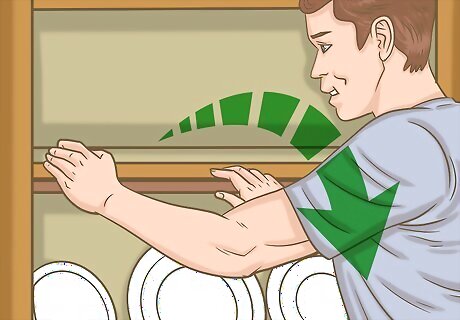
Clear the shelf where you want to display your plates. Plate racks can take up a lot of room on your shelf. Remove any dishes currently on the shelf where your rack will go to avoid damaging the pieces when you’re setting up your new arrangement. Set the dishes somewhere safe, like in the drawers underneath the cabinet or on a table that’s out of the way, so they don’t get broken.
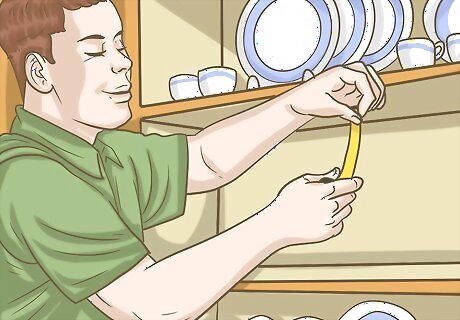
Measure the height and width of the shelves to determine your rack size. Plate racks come in all different shapes and sizes, so you’ll need to know how much space you have on your shelves before you choose one. Use a tape measure from the bottom of the shelf to the shelf directly above it to figure out the height, then measure from the back of the cabinet to the front to get the width. Keep in mind that your plates may stick up above the rack, too. So, for instance, if your shelf is 12 inches (30 cm) high and your largest plate is 10 inches (25 cm), you know that your rack can’t sit up more than 1 to 2 inches (2.5 to 5.1 cm) if you want the plate to fit. Some cabinets have shelves that you can adjust to make them higher or lower. Look on the inner sides of the cabinet to see if there are different peg holes that you can move the shelves to.

Choose a plate rack that will fit on the shelf and that matches your room. Use the measurements of your shelf to pick a rack that’s the right size. Then decide what material you’d like for your rack, whether it’s metal, clear plastic, or bamboo. Pick one that complements the theme or vibe of your room. For example, a wood plate rack is good for rustic or bohemian styles, while an ornate brass rack has a more vintage feel. You can buy plate racks from a housewares store or an online retailer.
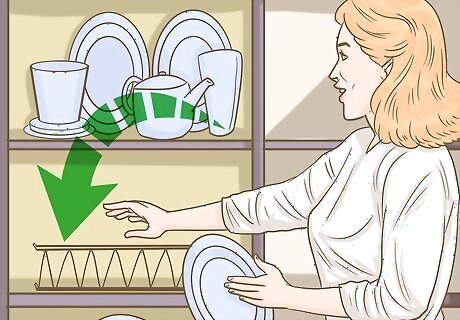
Set the rack on the shelf and arrange the plates from biggest to smallest. Position the rack so that it sits perfectly flat and is well-balanced. Place 1 plate in each section of the rack, starting with the largest plate in the back slot. Then add the smaller plates in decreasing height order in front of the biggest one. Make sure the plates are facing out towards the front of the cabinet. The backside of the plates should be resting against the back of the rack. If your plates have a pattern or picture in the center, stand them in the rack so that the design is rightside up.
Leaning Plates against the Back of the Cabinet

Remove all of the dishes from where you’re going to arrange your plates. This prevents you from having to reach over other pieces and potentially knocking them over or breaking them. Clear the entire shelf before you begin. Place the dishes somewhere where they won’t be disturbed or damaged while you work.

Set the largest plates in the groove, resting them against the cabinet wall. Use your hand to feel for the indentation towards the back of the shelf. Gently place the bottom of each of your tallest plates in the groove, and lean the tops against the back wall of the cabinet. It’s best to use bigger plates in the back because smaller pieces will likely get hidden if they’re behind larger ones. Dinner plates or serving dishes tend to be the largest. What if your cabinet has a plate rail instead of a groove? Some china cabinets have a plate rail instead of a groove. The rail is basically a very thin piece of wood that’s raised slightly from the shelf. Set the bottom of the plates behind the rail, then rest the backsides of the plates against the back of the cabinet.

Arrange the rest of your china collection in front of the plates. Once your largest plates are set up in the back of the cabinet, place the smaller pieces towards the front of the shelf. For example, group decorative bowls together or scatter teacups with their matching saucers around the plates. You can find sample china cabinet arrangements on sites like Pinterest or home decor blogs.













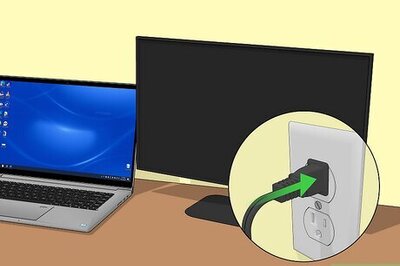
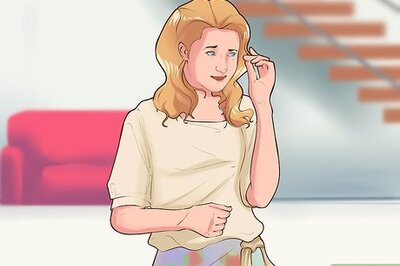





Comments
0 comment